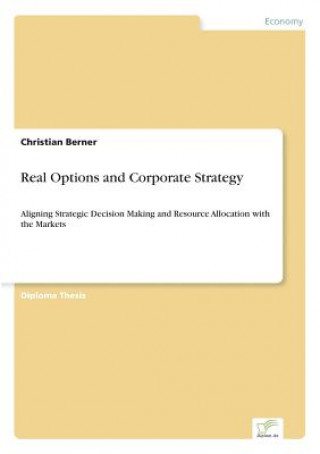
Livrare
Consilier de cumpărături





Nu se pretează? Nu contează! La noi puteți returna bunurile în 30 de zile
 Voucher cadou
orice valoare
Voucher cadou
orice valoare
Cu un voucher cadou nu veți da greș. În schimbul voucherului, destinatarul își poate alege orice din oferta noastră.
Real Options and Corporate Strategy
 engleză
engleză
 393 b
393 b
30 de zile pentru retur bunuri
Ar putea de asemenea, să te intereseze


Inhaltsangabe:Abstract: Every investment, for example new facilities, new products, or strategic partnerships is driven by the pursuit of creating żvaluesż. Major changes are going on in the valuation of investments. Although the żclassicż shareholder value concept is still a valuable source for identification of value drivers of strategic management, it needs to be extended in terms of its ability to evaluate long-term investment choices. Far too long capital budgeting has only been considered under aspects of its contribution to an overall added economic value rather than focusing on a firmżs resources. Recent research emphasized the strategic value of resources leading to formulate the approach of a żresource-based viewż of a firmżs activities. Usually management tries to capture future development with żstaticż methods of capital budgeting, i.e. future cash-flows are discounted with a fixed risk-adjusted discount rate. However, the finding of present values and capitalized values could produce pitfalls in investment decisions. Strategic investment decisions are often characterized by a wide range of possibilities to react flexibly to the changing business environment. This area of tolerance in investment decisions could not be captured with traditional instruments of investment evaluation. In the 1970s, the discounted-cash-flow analysis (DCF) emerged and proved its practicability. This method assumes a żnowż or żneverż approach in undertaking a project. Some authors suggest adding the theory of option prices to investment decisions, as in the 1970s and the 1980s developments in the valuation of capital-investment opportunities based on option pricing revolutionized capital budgeting. Option pricing allows adaptation and revision of future decisions in order to capture managerial flexibility and to finally capitalize on any possible future development. To incorporate these real options means to limit losses and offers a vital contribution to long-term corporate success, especially in those marketplaces characterized by uncertainty and rapid change. This method also explains the value of waiting for the initial project and considers its value in comparison to the opportunity costs of waiting. These costs are dictated by the behavior of competitors and loss of cash-flow streams from the project. Incorporating this method could possibly lead to a better understanding of the importance of resource allocation, the value of strategic investments and the interdependencies between uncertainty and irreversibility of a project. Through identification of additional value drivers and proper management, the resources are allocated optimally, contributing to the overall goal of formulating a strategy to survive in an uncertain environment. The informational content of option prices and their żforward-lookingż character is an improvement of well used traditional tools in investment decisions and the above mentioned idea of shareholder value as it lays the foundation to evaluate future projects with more accuracy with methods that are approved by financial markets. A growing body of research (see literature) recognizes these values of options. However, this new insight is often separated from creating an overall corporate strategy that leads to more value for companies and their stakeholders. Finally, the option approach to capital budgeting also offers techniques to capture strategic value of technology, interdependencies between related projects and competitive interaction. The important area that badly deserves attention is the area of competition and strategy. The real options potential makes a significant difference in evaluating sustainable competitive advantages resulting from strategic investments such as patent, proprietary technologies, ownership of valuable resources, managerial capital, reputation or brand name, scale and market power. This thesis discusses the real option approach...
Informații despre carte
 engleză
engleză


 Contact
Contact Cum să cumpăr
Cum să cumpăr




















